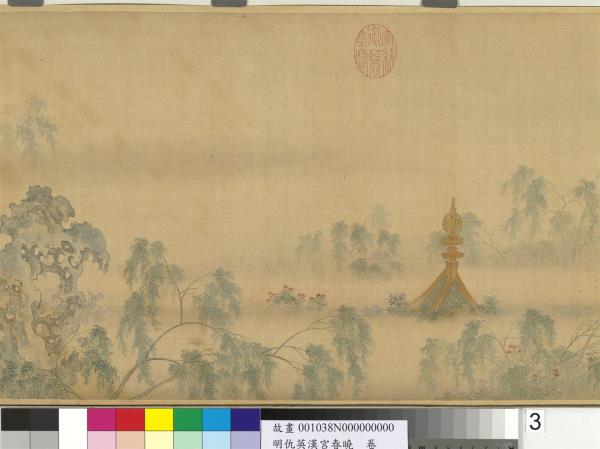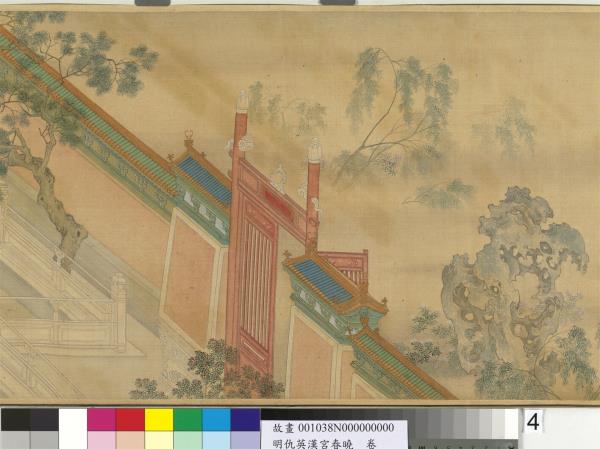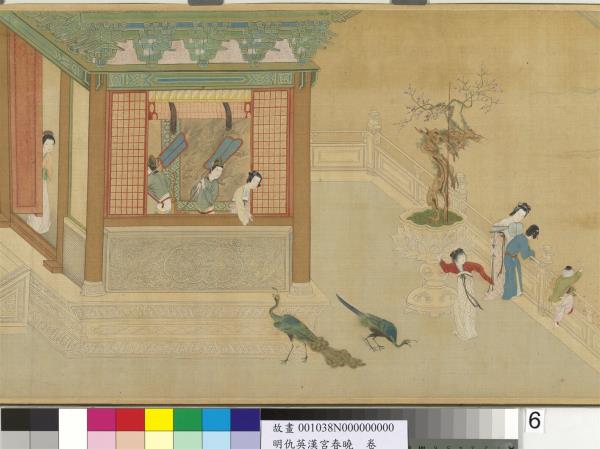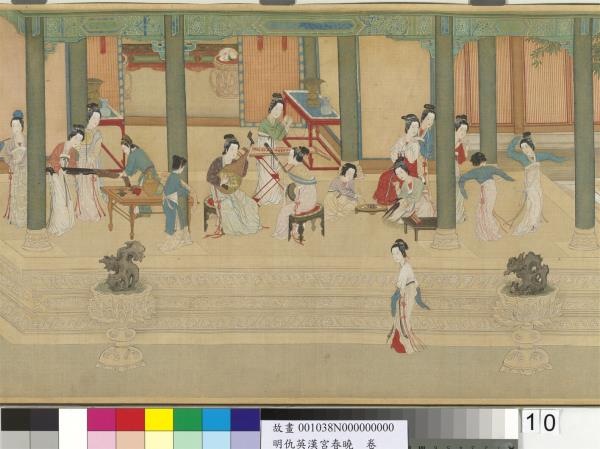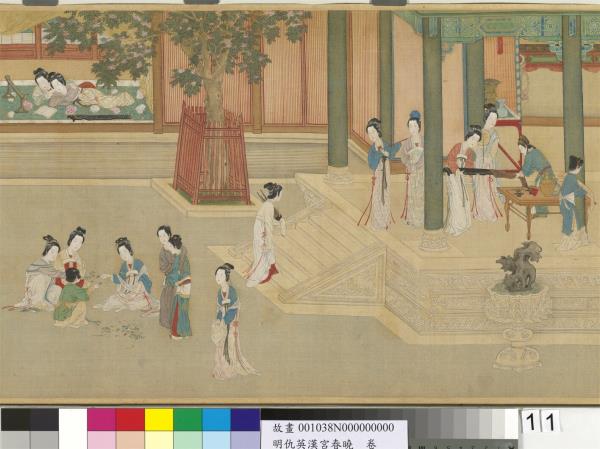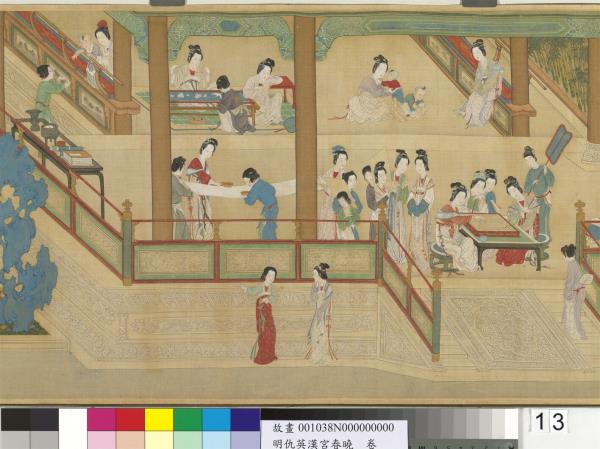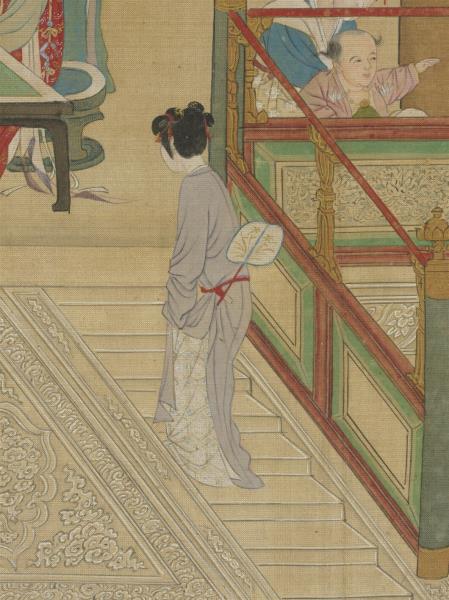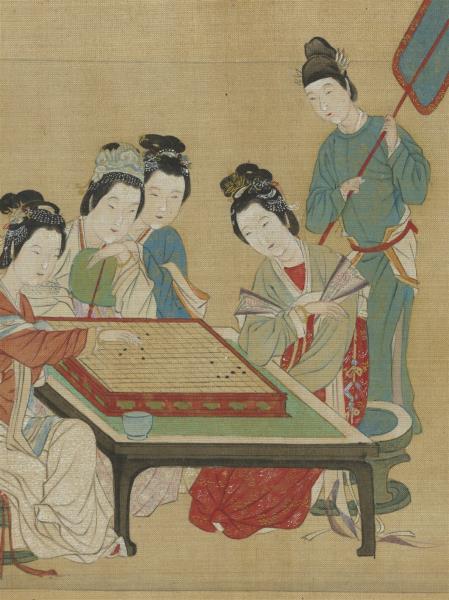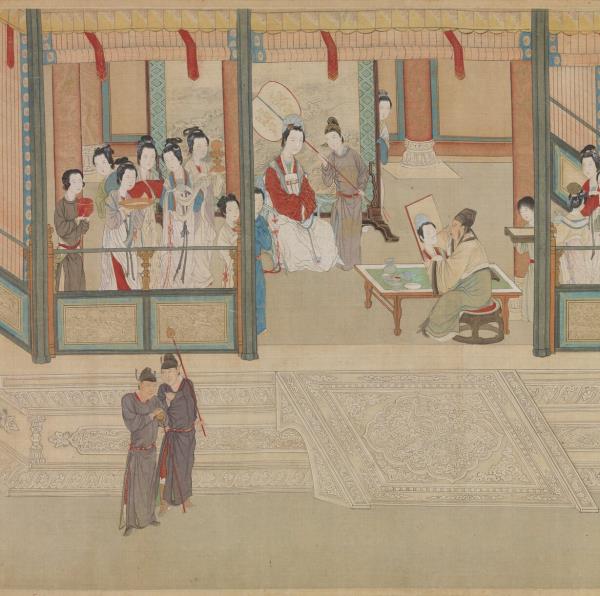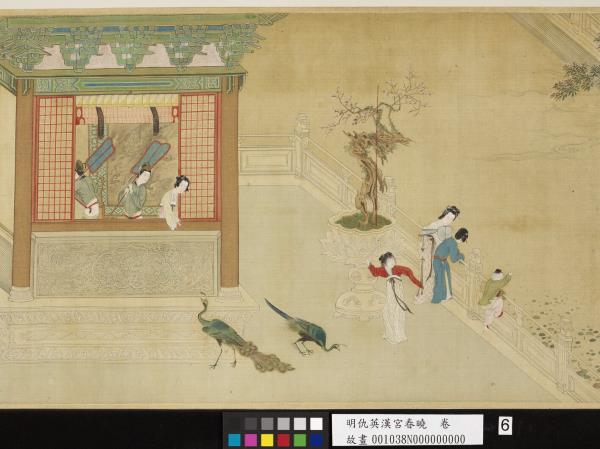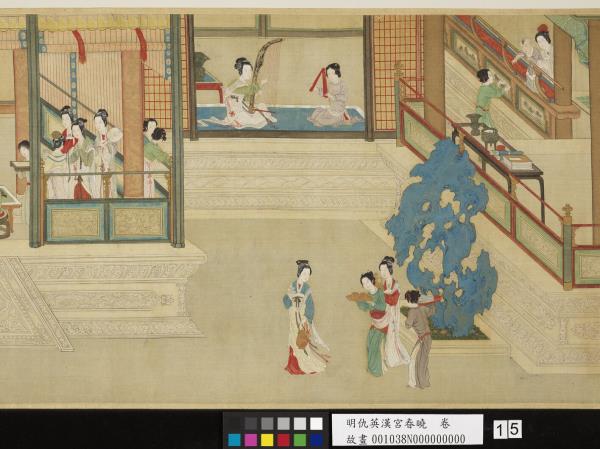| 文物統一編號 |
故畫001038N000000000
|
| 作品號 |
故畫00103800000 |
| 品名 |
明仇英漢宮春曉 卷
Spring Dawn in the Han Palace |
| 分類 |
繪畫 |
| 作者 |
仇英,Qiu Ying |
| 數量 |
一卷 |
| 位置 |
尺寸(公分) |
| 隔水一 |
30.6x11.5 |
| 隔水二 |
30.6x11.6 |
| 本幅 |
30.6x574.1 |
| 印記類別 |
印主 |
印記 |
| 收傳印記 |
項元汴 |
子京 |
| 收傳印記 |
項元汴 |
子京父印 |
| 收傳印記 |
項元汴 |
子京父印(重一) |
| 收傳印記 |
項元汴 |
子孫世昌(重一) |
| 收傳印記 |
項元汴 |
子孫永保(重一) |
| 收傳印記 |
項元汴 |
六藝之圃 |
| 收傳印記 |
項元汴 |
天籟閣 |
| 收傳印記 |
項元汴 |
平生真賞 |
| 收傳印記 |
項元汴 |
沮溺之儔 |
| 收傳印記 |
項元汴 |
品(重一) |
| 收傳印記 |
項元汴 |
宮保世家 |
| 收傳印記 |
項元汴 |
桃花源裡人家 |
| 收傳印記 |
項元汴 |
神(重一) |
| 收傳印記 |
項元汴 |
神游心賞 |
| 收傳印記 |
項元汴 |
退密 |
| 收傳印記 |
項元汴 |
寄敖 |
| 收傳印記 |
項元汴 |
項子京家珍藏 |
| 收傳印記 |
項元汴 |
項元汴印 |
| 收傳印記 |
項元汴 |
項氏子京 |
| 收傳印記 |
項元汴 |
項叔子 |
| 收傳印記 |
項元汴 |
項墨林父祕笈之印(重一) |
| 收傳印記 |
項元汴 |
項墨林鑑賞章(重一) |
| 收傳印記 |
梁清標 |
圖史自娛 |
| 收傳印記 |
梁清標 |
蒼巖子 |
| 收傳印記 |
項元汴 |
墨林子 |
| 收傳印記 |
項元汴 |
墨林山人 |
| 收傳印記 |
項元汴 |
墨林生 |
| 收傳印記 |
項元汴 |
墨林祕玩 |
| 收傳印記 |
梁清標 |
蕉林玉立氏圖書 |
| 收傳印記 |
梁清標 |
蕉林收藏 |
| 收傳印記 |
梁清標 |
蕉林鑑定 |
| 收傳印記 |
項元汴 |
檇李項氏士家寶玩 |
| 收傳印記 |
梁清標 |
觀其大略 |
| 鑑藏寶璽 |
清高宗 |
石渠寶笈 |
| 鑑藏寶璽 |
宣統帝 |
宣統御覽之寶 |
| 鑑藏寶璽 |
清高宗 |
乾隆御覽之寶 |
| 鑑藏寶璽 |
清高宗 |
御書房鑑藏寶 |
| 鑑藏寶璽 |
清仁宗 |
嘉慶御覽之寶 |
| 主題類別 |
主題(第一層) |
主題(第二層) |
主題說明 |
| 主要主題 |
人物 |
仕女 |
|
| 主要主題 |
人物 |
侍從(侍女、童僕) |
侍女 |
| 主要主題 |
山水 |
春景 |
|
| 主要主題 |
建築 |
宮殿 |
|
| 主要主題 |
器用 |
傢俱(屏風) |
銅鏡.奩 |
| 次要主題 |
人物 |
孩童 |
|
| 次要主題 |
山水 |
奇石 |
|
| 次要主題 |
建築 |
池水 |
|
| 次要主題 |
建築 |
庭院 |
|
| 次要主題 |
建築 |
欄杆 |
|
| 次要主題 |
建築 |
籬笆、圍牆 |
圍牆 |
| 次要主題 |
樹木 |
松 |
|
| 次要主題 |
樹木 |
柏 |
|
| 次要主題 |
樹木 |
楊柳 |
|
| 其他主題 |
人物 |
后妃 |
|
| 其他主題 |
人物 |
軍士 |
|
| 其他主題 |
人物 |
畫師 |
|
| 其他主題 |
山水 |
溪澗、湍泉 |
溪澗 |
| 其他主題 |
走獸 |
貓(貍奴) |
貓 |
| 其他主題 |
建築 |
亭 |
|
| 其他主題 |
建築 |
迴廊 |
|
| 其他主題 |
建築 |
臺閣 |
|
| 其他主題 |
草蟲 |
蝶蛾 |
|
| 其他主題 |
翎毛 |
|
|
| 其他主題 |
翎毛 |
孔雀 |
|
| 其他主題 |
翎毛 |
鴛鴦 |
|
| 其他主題 |
翎毛 |
鸚鵡 |
|
| 其他主題 |
器用 |
文玩(琴棋書畫) |
|
| 其他主題 |
器用 |
如意 |
|
| 其他主題 |
器用 |
花器 |
澆花器 |
| 其他主題 |
器用 |
香爐.火盆 |
|
| 其他主題 |
器用 |
扇 |
|
| 其他主題 |
器用 |
耕織漁獵 |
織(刺繡.女紅用具.針.線) |
| 其他主題 |
器用 |
飲食器 |
|
| 其他主題 |
器用 |
樂器 |
琵琶.箏.琴.排簫.笛.箜篌 |
| 其他主題 |
器用 |
鞦韆 |
|
| 其他主題 |
樹木 |
竹 |
|
| 技法 |
技法細目 |
| 人物衣紋描法(勻稱線條) |
|
| 工筆 |
|
| 界畫 |
|
| 皴法 |
|
| 類別 |
參考資料 |
| 內容簡介 |
1.本幅以春日晨曦中的漢代宮廷為題,描繪後宮佳麗百態;其中,並包含畫師毛延壽為王昭君寫像的著名故實。 通幅構景繁複,用筆清勁而賦色妍雅,林木奇石與華麗的宮闕穿插掩映,舖陳出宛如仙境般的瑰麗景象。除卻美女群像之外,復融入琴棋書畫、鑑古、蒔花等文人的休閒活動,誠為仇英歷史故事畫中的精彩力作。此畫係為項元汴所作,完成時間約在嘉靖廿一年(一五四二)以後。
|
| 內容簡介 |
仇英(約西元一四九四至一五五二年),江蘇太倉人。字實父,號十洲。初執事丹青(一說作漆工),周臣異而教之,後遂成名。所作有畫院之精能而饒士氣,為明四大家之一。漢宮春曉,蓋寫宮中嬪妃生活,借皇家園庭殿宇之盛,以騁其華縟藻麗之筆耳。所傳畫本甚多,有畫毛延壽為嬪妃寫照者,亦有不畫此景者,可知初無一定故事。仇英此卷,鉤勒秀勁而設色妍雅,實屬院藏同類題材中之最佳者。
|
| 內容簡介 |
仇英(約西元一四九四-一五五二年),字實父,號十洲。所作有畫院之精能而饒士氣,為明四大家之一。本幅以春日晨曦中的漢代宮廷為題,描繪後宮佳麗百態。通幅構景繁複,用筆清勁而賦色妍雅,林木奇石與華麗的宮闕穿插掩映,舖陳出宛如仙境般的瑰麗景象,為仇英歷史故事畫中的精彩力作。此畫係為項元汴所作,卷首有千字文第七四二「慮」字編號,卷末有項氏「價值兩百金」語。
|
| Description |
Qiu Ying painted with the precision of an academy master but had a rich literati touch, making him one of the Four Ming Masters. This work is an imaginary spring morning in a Han dynasty palace depicting the women’s quarters. The composition is complex, the brushwork pure and strong with beautiful yet elegant colors. Interspersed among trees and decorative rocks are opulent palatial buildings, unveiling magnificent scenery similar to a land of immortals and making this a masterpiece of Qiu’s historical/narrative painting. This work was in Xiang Yuanbian’s collection, using the 742nd character (lu 慮) from the “Thousand Character Classic” as an accession number at the front of the scroll. At the end he recorded that its “value is 200 gold.”
|
| Description |
Spring Dawn in the Han Palace Ch’iu Ying (ca. 1494-1552) Ming Dynasty (1368-1644) Spring Dawn is a vivid portrayal of the lavish lifestyle of the Han dynasty (206 B.C.-A.D. 220) imperial harem, which was long a favorite theme of Chinese painters. Ch’iu Ying’s version is one of the most brilliantly accomplished of these and is the finest of such works in the museum. Unlike many other paintings of the Han seraglio this one depicts the semi-apocryphal court painter Mao Yen-shou, who is here shown painting portraits of the imperial consorts, which the emperor used to select from his many beauties. The woman now sitting for her portrait is possibly the legendary beauty Wang Chao-Chun, who failed to bribe the artist to create a lovlier-than-life resemblance. Her portrait was correspondingly unflattering, and she was neglected by the emperor. When she was eventually sent away from the court to wed a foreigner, the emperor finally saw how beautiful she was and regretted having dismissed her. The painter was executed. Ch’iu Ying, one of the "Four Masters of the Ming," was a native of T’ai-ts’ang, Kiangsu. Originally a painting artisan (by some accounts a lacquer artist), he studied under Chou Ch’en (fl. 1500-1535) and created paintings that combined the finish of the academy style with the spirit of literati painting.
|
| Description |
This work represents various activities in a Han dynasty (206 BC-AD 220) palace on a spring morning. Among them is the famous story of Mao Yen-shou painting the portrait of Wang Chao-chun. The intricate composition is rendered with crisp and strong brushwork and beautiful colors. The lavish palace scenes are punctuated by trees and decorative rocks, creating marvelous scenery similar to that of the immortals. In addition to the groups of beauties, leisure activities of the literati, such as the zither, chess, calligraphy, and painting as well as appreciating antiquities and planting folwers are shown. This masterpiece of historical narrative painting by ch'iu Ying was done for Hsiang Yuan-pien and completed after 1542.
|
| 收藏著錄 |
石渠寶笈初編(御書房),下冊,頁1055
|
| 收藏著錄 |
故宮書畫錄(卷四),第二冊,頁183
|
| 收藏著錄 |
故宮書畫圖錄,第十八冊,頁361-366
|
| 參考書目 |
1.王耀庭,〈(傳)明仇英漢宮春曉圖〉,收入王耀庭主編,《傳移模寫》(臺北:國立故宮博物院,2007年初版),頁24-25。
2.劉芳如,〈明仇英漢宮春曉〉,收入國立故宮博物院編輯委員會編,《明中葉人物畫四家特展-杜菫、周臣、唐寅、仇英》(臺北:國立故宮博物院,2000年初版),頁167-170。
3.劉芳如,〈仇英漢宮春曉〉,收入劉芳如、張華芝主編,《群芳譜 — 女性的形象與才藝》(臺北:國立故宮博物院,2003年初版一刷),頁50。
4.劉芳如,〈明仇英漢宮春曉〉,收入國立故宮博物院編輯委員會編,《仕女畫之美》(臺北:國立故宮博物院,1988年四月初版),頁84-85。
5.賴毓芝,〈明仇英漢宮春曉〉,《故宮文物月刊》,第300期(2008年3月),頁36-37。
6.石守謙,〈洛神賦圖:一個傳統的形塑與發展 〉,《國立臺灣大學美術史研究集刊》,第23期(2007),頁51-80。
7.劉芳如,〈明仇英漢宮春曉〉,收入蔡玫芬主編,《精彩一百 國寶總動員》(臺北:國立故宮博物院,2011年九月初版一刷),頁320。
8.陳葆真;〈康熙皇帝的生日禮物與相關問題之探討〉,《故宮學術季刊》,第三十卷第一期(2012年秋季號),頁1-52。
|
| 網頁展示說明 |
仇英(約1494-1552),字實父,號十洲。所作有畫院之精而饒士氣,為明四大家之一。
本幅以春日晨曦中的漢代宮廷為背景,描繪佳麗百態,其中並穿插毛延壽為王昭君寫像的情節。通幅構景繁複,用筆清勁而賦色妍雅,林木奇石與華麗的宮闕交互掩映,鋪陳出宛如仙境般的瑰麗景象。除卻美女群像之外,復融入琴棋書畫、鑑古、蒔花等文人休閒活動,誠為仇英歷史故事畫中的精彩力作。(20110913)
|
| 網頁展示說明 |
Qiu Ying (style name Shifu, sobriquet Shizhou) did paintings with the refinement of the Painting Academy and the atmosphere of scholar artists, becoming known as one of the Four Ming Masters.
This work takes as its background a spring dawn in the Han dynasty palaces. Ladies are depicted in various activities, and the story of Mao Yanzhou doing the portrait of Wang Zhaojun is interwoven within. The scenery throughout the work is complex, the brushwork pure and strong with coloring beautiful and refined. The trees and decorative rocks play off the gorgeous palace architecture, unfolding magnificent scenery not unlike a realm of the immortals. Not only depicting groups of beauties, the painting also incorporates the literati leisure activities of the zither, “go,” painting, and calligraphy; appreciating antiquities; and cultivating flowers. Thus, it ranks as a masterpiece among Qiu Ying’s historical narrative paintings.
(20110913)
|
| 參考書目 |
賴毓芝,〈明仇英漢宮春曉 卷〉,收入邱士華、林麗江、賴毓芝主編《偽好物-16~18世紀蘇州片及其影響》(臺北:國立故宮博物院,2018.04),頁110-115。
|
| 參考書目 |
劉芳如,〈明仇英漢宮春曉 卷〉,收入劉芳如主編《她-女性形象與才藝》(臺北:國立故宮博物院,2020.10),頁96-103、260-261。
|
| 參考書目 |
許文美、劉芳如,〈明仇英漢宮春曉 卷〉,收入《明四大家特展-仇英》(臺北:國立故宮博物院,2014.10),頁70-83、273、321。
|
本院文物保存維護依〈國立故宮博物院典藏文物管理作業要點〉及〈國立故宮博物院文物修護業務作業原則〉辦理
抽盤點紀錄
修護紀錄



